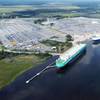The Port Authority Board of Commissioners has authorized a study harbor dredging in the Port of New York and New Jersey to identify, develop and explore innovative and cost-effective ways to remove and dispose of sediment from the port's channels and berths.
The goal of the $4 million study is to find the most environmentally sensitive and the most effective way to deepen the port's channels to 45-ft. and then to 50-ft. The deeper channels are needed to accommodate a new generation of cargo megaships that can handle over 6,000 truck-size containers and require deep water to operate. The study will be done in two phases. The first, which will take approximately two years, will examine what the Port Authority can do to help private industry develop new technologies to process dredged material more efficiently and reduce the cost of recycling and reusing it. The second phase will explore long-term methods to improve the entire dredging and disposal process, unchanged for decades.
"The Port is a primary cog for our regional economy, and we want to ensure that it remains the economic engine that continues to create jobs and opportunities for New Yorkers." said New York governor, George E. Pataki. "To sustain this level of activity, it is imperative that we upgrade our port infrastructure to ensure that we meet the demands for growth that will be placed on our maritime transportation system, while protecting and enhancing the environment."
New Jersey governor Christie Whitman said, "We must continue the positioning of our Ports as a hub for maritime activity on the East Coast if we are to sustain the economic benefits that it provides. We also are keenly aware in New Jersey of the environmental sensitivities associated with dredging. This action will address the need to upgrade our port facilities to accommodate modern, larger vessels in an environmentally sound manner."
"The vitality of our Port and the economic prosperity it brings to the region hinges on our ability to provide the infrastructure needed for modern maritime operations, including accommodating a new generation of immense deep-draft ships," said Port Authority chairman Lewis M. Eisenberg. 'We must ensure that we are prepared to handle the projected increases on maritime cargo, which will double in 10 years and could more than quadruple in 40 years, creating 238,000 additional jobs and $65 billion in economic activity. And we must continue to do everything possible to protect the environment."
"Much of the dredging technology we currently use in the Port has been in place for decade and is not as cost-efficient or practical as we believe it can and should be," said Port Authority executive director, Robert E. Boyle. "Working with the two states and the dredging industry, this study will help identify how we can enhance the performance of dredging operations and control disposal costs to make sure our Port remains economically competitive with others around the country. Any changes that are made must be done in an environmentally sensitive manner."
Port Authority's director of commerce, Richard M. Larrabee said a demonstration project is exploring the possible dredge material to build highway embankments. Research also has been conducted on the use of dredged material to make products such as construction aggregate, concrete and bricks. In addition, dredged materials have been used to cover former landfills and to reclaim abandoned industrial land of "brownfields." Several such projects have either been completed or are under way in the region, and others are planned.
During the next 12 years, channel deepening will require the excavation and disposal of approximately 59 million cubic yards of sediment and rock. In addition, annual maintenance dredging results in an additional 2-million cubic yards of sediment in need of disposal.
Regulatory changes also have made dredging and disposal of sediment a major challenge for marine terminal operators.
In 1997, the federally mandated ocean disposal site, Mud Dump, was closed and re-designated as the Historic Area Remediation Site (HARS). Currently, only clean dredged material can be taken to the site.
Sponsored Content
LR - Fit for 55: Managing compliance and optimising operations

Use Roxtec seals, services and software

Subscribe for
Maritime Reporter E-News
Maritime Reporter E-News is the maritime industry's largest circulation and most authoritative ENews Service, delivered to your Email five times per week









